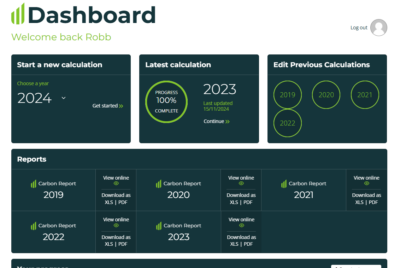What Are Scope 3 Emissions?
If you’re a small business owner beginning your net zero journey, you may have heard the terms Scope 1, 2, and 3 emissions.
Scope 1 covers emissions you generate on site or from assets you own – for example burning gas in a boiler. Scope 2 covers emissions from energy you import – for most businesses, that just means electricity.
Scope 3 covers everything else – all the indirect emissions that occur in your company’s value chain. They’re the carbon emissions that your business is indirectly responsible for, occurring beyond your immediate operations but linked to your business activities.
Scope 3 includes all your suppliers, transport, materials, and the lifecycle of products you sell.
Why Scope 3 matters
Scope 3 can be complex – most business’s value chains are complicated and have multiple layers. But they’re also where most carbon emissions lie. Scope 3 emissions typically account for more than 70% of an average carbon footprint. Even if you’re a small operation, your greatest environmental impact may lie in your supply chain or how customers use your products.
Tracking your Scope 3 emissions – or at least the emissions hotspots in your Scope 3 – is important for:
- Meeting customer and investor expectations
- Preparing for future net zero regulations
- Identifying cost-saving opportunities
- Building a genuinely sustainable business model
- Having a positive influence beyond your own business.
Common sources of Scope 3 emissions
Your business’s Scope 3 emissions might come from:
- Purchased goods and services: The carbon footprint of everything you buy, from office supplies to raw materials
- Business travel: Flights, train journeys, and hotel stays
- Employee commuting: How your team gets to work
- Transportation and distribution: Moving products to customers
- Waste disposal: What happens to your waste after it leaves your premises
- Use of sold products: Energy used by customers when using your products
- End-of-life treatment: How your products are disposed of or recycled
Getting started with Scope 3 measurement
We don’t advocate tracking every aspect of your Scope 3 emissions – that would be daunting and impossible for most businesses.
Instead, identify areas where you think you can have the biggest impact.
If you’ve got as large team, for example, you could choose to track employee commuting. If you’re a manufacturing business, you could choose the top 3 raw materials you use.
Focusing on the areas that matter most will help you get going without feeling overwhelmed. Over time, as you get confident developing tracking and monitoring systems, you can add more aspects.
The bigger picture
Because tackling Scope 3 emissions requires looking beyond your immediate business operations, it can offer big opportunities. By working with suppliers, customers, and employees to reduce emissions throughout your value chain, you’ll begin to embed sustainability throughout your operations and unlock the many business benefits of doing so.
